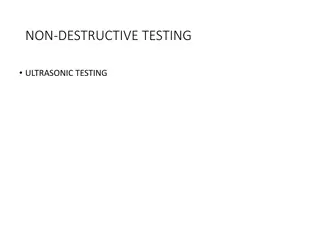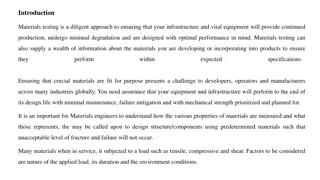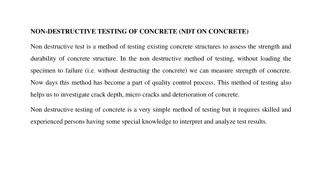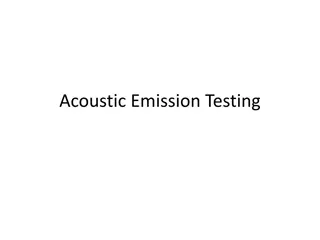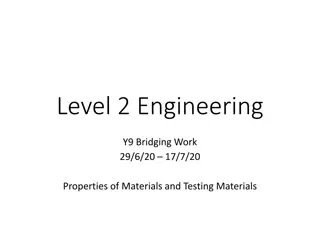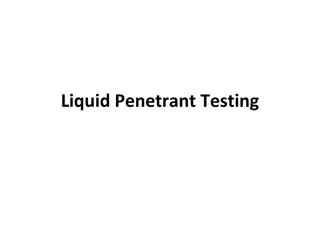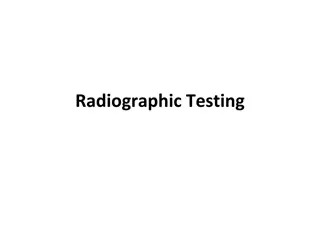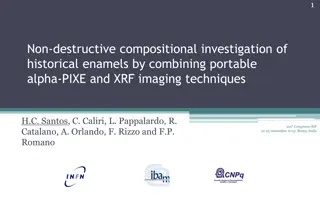
Introduction to Non-Destructive Testing (NDT) Methods in Engineering Studies
Learn about the importance of Non-Destructive Testing (NDT) methods for assessing materials in Civil Structures in Year 12 Engineering Studies. Explore Destructive Testing techniques involving material failure vs. Non-Destructive Testing methods like radiographic, dye penetrant, ultrasonic, and magnetic particle testing. Discover how these tests help identify defects without causing damage to the materials.
Download Presentation

Please find below an Image/Link to download the presentation.
The content on the website is provided AS IS for your information and personal use only. It may not be sold, licensed, or shared on other websites without obtaining consent from the author. If you encounter any issues during the download, it is possible that the publisher has removed the file from their server.
You are allowed to download the files provided on this website for personal or commercial use, subject to the condition that they are used lawfully. All files are the property of their respective owners.
The content on the website is provided AS IS for your information and personal use only. It may not be sold, licensed, or shared on other websites without obtaining consent from the author.
E N D
Presentation Transcript
Non- Destructive Testing of Materials Year 12 Engineering Studies Civil Structures
Testing of Materials Destructive Testing; involves testing of materials until failure resulting in destruction of test piece or sample. Destructive tests are generally carried out to determine the mechanical properties of materials - tensile/compression testing - impact testing - transverse beam testing Non-destructive testing; involves examination of materials and components for defects and flaws either as part of the manufacturing process or during routine maintenance checks - hardness testing - dye penetrant testing - radiographic testing (X-ray) - ultrasonic testing - magnetic particle testing 2
Radiographic Testing (X-ray) uses either x-rays or gamma rays to examine the internal structure of manufactured components identifying any flaws or defects the test-part is placed between the radiation source and film (or detector). X-rays that passing through the object are captured behind the object by a detector (either photographic film or a digital detector) faults and defects such as internal cracks and voids will appear as white areas on the exposed film https://youtu.be/zrrHbK3kKF8 3
Dye Penetrant Testing used to detect surface cracking in component after cleaning the component is sprayed with a coloured or fluorescent die which seeps in the crack after rinsing a developer is applied which draws the die out of the crack and is either visible to the naked eye (colour contrast) or under ultraviolet light (fluorescent die) https://www.youtube.com/watch?v=xEK-c1pkTUI 4
Ultrasonic Testing used to detect sub-surface cracking and defects such as delamination of laminated materials sound waves are passed through the material and reflected back to a receiver sound waves that hit a defect are reflected back sooner and allow identification of the defect has the advantage of only requiring access to on side of the component https://www.youtube.com/watch?v=UM6XKvXWVFA 5
Magnetic Particle Testing a magnetic field is generated in the component to be tested magnetic particles are either sprinkled over the component or applied in a suspension fluid the particles will congregate at the site of a defect due to the disruption of the magnetic field that occurs at the defect https://www.youtube.com/watch?v=UM6XKvXWVFA 6
Non-destructive testing https://youtu.be/tlE3eK0g6vU 7

